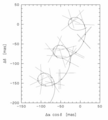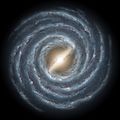Hipparcos Catalogue facts for kids
The Hipparcos Catalogue is a special list of stars. It's named after an ancient Greek astronomer called Hipparchus. He was one of the first people to carefully map the positions of stars in the sky. The Hipparcos Catalogue helps us know exactly where many stars are located. Each star in this list has a special code like HIP or HP.
Contents
What is the Hipparcos Catalogue?
The Hipparcos Catalogue is a huge collection of information about stars. It was created using data from a special satellite named Hipparcos. This satellite was launched by the European Space Agency (ESA) in 1989. Its main job was to measure the positions, distances, and movements of stars with incredible accuracy.
Why is it important?
Before Hipparcos, astronomers had less accurate maps of the sky. The Hipparcos satellite changed that. It measured the positions of over 118,000 stars with very high precision. This made the Hipparcos Catalogue the most accurate star map of its time.
Measuring stars from space
Measuring stars from Earth can be tricky because of our atmosphere. The Hipparcos satellite orbited above the atmosphere. This allowed it to get much clearer and more precise measurements. It used special tools to look at stars from two different angles at the same time. This helped it figure out their exact positions and how far away they are.
Understanding star movements
Stars are not fixed in space; they are always moving. The Hipparcos mission also measured how stars move across the sky. This movement is called "proper motion." By knowing a star's proper motion, scientists can better understand how our Milky Way galaxy is structured and how it moves.
What did Hipparcos discover?
The Hipparcos Catalogue helped astronomers make many important discoveries. It improved our understanding of the Universe.
- More accurate distances: The satellite measured the distances to many stars more precisely than ever before. Knowing a star's distance is key to understanding its true brightness and size.
- Better star maps: The catalogue became a standard reference for mapping the sky. It helped create more accurate star charts and navigation systems.
- Understanding our galaxy: By tracking the movements of thousands of stars, scientists gained new insights into how our Milky Way galaxy spins and how stars orbit its center.
The Hipparcos mission ended in 1993, but its data is still used today. It laid the groundwork for future missions that continue to explore the stars.
Images for kids
-
Optical micrograph of part of the main modulating grid (top) and the star mapper grid (bottom). The period of the main grid is 8.2 micrometres.
-
Principles of the astrometric measurements. Filled circles and solid lines show three objects from one field of view (about 1° in size), and open circles and dashed lines show three objects from a distinct sky region superimposed by virtue of the large basic angle. Left: object positions at one reference epoch. Middle: their space motions over about four years, with arbitrary proper motion vectors and scale factors; triangles show their positions at a fixed epoch near the end of the interval. Right: the total positional changes including the additional apparent motions due to annual parallax, the four loops corresponding to four Earth orbits around the sun. The parallax-induced motions are in phase for all stars in the same region of sky, so that relative measurements within one field can only provide relative parallaxes. Although the relative separations between the stars change continuously over the measurement period, they are described by just five numerical parameters per star (two components of position, two of proper motion, and the parallax).
-
The path on the sky of one of the Hipparcos Catalogue objects, over a period of three years. Each straight line indicates the observed position of the star at a particular epoch: because the measurement is one-dimensional, the precise location along this position line is undetermined by the observation. The curve is the modelled stellar path fitted to all the measurements. The inferred position at each epoch is indicated by a dot, and the residual by a short line joining the dot to the corresponding position line. The amplitude of the oscillatory motion gives the star's parallax, with the linear component representing the star's proper motion.
-
Artist's concept of our Milky Way galaxy, showing two prominent spiral arms attached to the ends of a thick central bar. Hipparcos mapped many stars in the solar neighbourhood with great accuracy, though this represents only a small fraction of stars in the galaxy.
See also
 In Spanish: Catálogo Hipparcos para niños
In Spanish: Catálogo Hipparcos para niños




